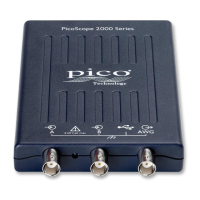Glossary12
Copyright © 2013 Pico Technology Limited. All rights reserved.ps2200a.en r1
4 Glossary
AWG—Arbitrary waveform generator. This output can be used to drive a test signal
from the BNC socket marked AWG into an external circuit or into one of the
oscilloscope's input channels (using a BNC cable). The PicoScope software allows the
generator to output standard waveforms, such as sine and square waves, or arbitrary
waveforms defined by the user.
Analog bandwidth—The frequency at which the measured signal amplitude is
3 decibels below the true signal amplitude.
Block mode—A fast data collection mode. The PicoScope software puts the
oscilloscope into this mode to achieve the fastest possible sampling rates. The
oscilloscope collects data as fast as possible and then stops to transfer the data to the
PC. During data transfer to the PC in block mode, the oscilloscope cannot sample data
from its inputs.
Buffer size—The size of the oscilloscope's buffer memory, measured in samples. The
buffer allows the oscilloscope to sample data faster than it can transfer it to the
computer.
Coupling mode—To switch from AC coupling to DC coupling, or vice versa, select AC
or DC from the control on the PicoScope toolbar. The AC setting filters out very low-
frequency components of the input signal, including DC, and is suitable for viewing
small AC signals superimposed on a DC or slowly changing offset. In this mode you
can measure the peak-to-peak amplitude of an AC signal but not its absolute value.
Use the DC setting for measuring the absolute value of a signal.
Device Manager—Device Manager is a Windows program that displays the current
hardware configuration of your computer. Right-click on 'My Computer,' choose
'Properties', then click the 'Hardware' tab and the 'Device Manager' button.
Driver—A program that controls a piece of hardware. The driver for the PicoScope
2200A Series PC Oscilloscopes is supplied in the form of a 32-bit Windows DLL,
ps2000a.dll, or ps2000.dll. This is used by the PicoScope software to control the
oscilloscope.
ETS—Equivalent Time Sampling. Constructs a picture of a repetitive signal by
accumulating information over many similar wave cycles. This allows the oscilloscope
to create a composite cycle that has more samples, and therefore better time
resolution, than a single cycle. ETS cannot be used for one-shot signals.
GS/s—Billions of samples per second. Used to quantify the sampling rate of an
oscilloscope.
Maximum sampling rate—A figure indicating the maximum number of samples the
oscilloscope can acquire per second. The higher the sampling rate of the oscilloscope,
the more accurate the representation of the high-frequency details in a fast signal.
MS/s—Millions of samples per second. Used to quantify the sampling rate of an
oscilloscope.
PC Oscilloscope—A virtual instrument formed by connecting a PicoScope oscilloscope
to a computer running the PicoScope software.
PicoScope software—A software program that accompanies all Pico PC
Oscilloscopes. It turns your PC into an oscilloscope, spectrum analyser, and meter
display.

